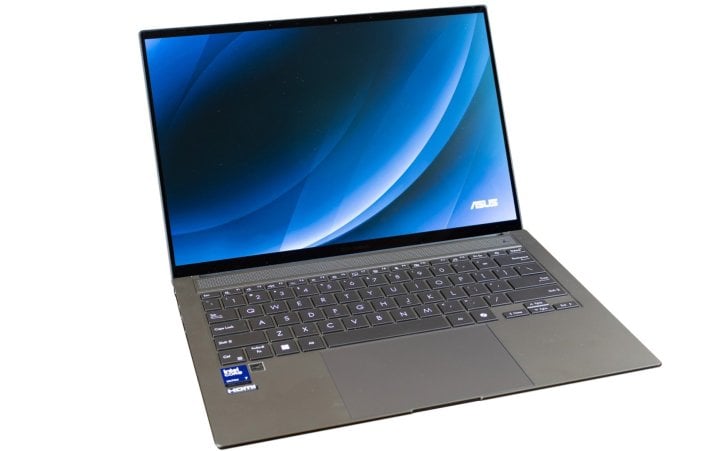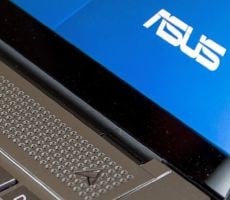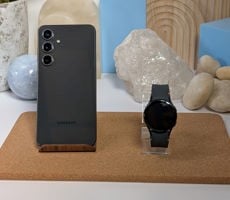ASUS Zenbook S 14 Review: This Luxurious Lunar Lake Laptop Impresses
Gaming On Lunar Lake: Our Impressions
Considering the new GPU architecture at play in Lunar Lake, we naturally had to try out a whole pile of games on the Core Ultra 256V. In terms of raw specifications, this part is actually pretty similar on the surface to AMD's Phoenix SoC that powers the ROG Ally and many other gaming handhelds. While this Zenbook isn't a gaming system, we wanted to get an idea of how future handhelds based on this SoC might game, and also a sneak peek at what Battlemage could be like.Like virtually all integrated graphics solutions on x86 PCs, we're strapped for bandwidth. It's not that the 128-bit LPDDR5X memory is slow, it's just that in terms of transfer rate, it doesn't really compare to the fast GDDR6 memory used by discrete graphics processors. The simplest way to cut down on memory bandwidth requirements in games is to reduce the render resolution. This system comes with a rather high resolution OLED, though, so we had to run most games with a 0.5x linear scale, or 25% resolution of 1440×900.
With that caveat out of the way, how well does the ASUS Zenbook S 14 with Lunar Lake handle games? Pretty well, actually, all things considered. Generally speaking, in 1440×900, you can crank the settings on whatever game just about as high as you want and it will play well enough. In GTA V, we ran the game in 2880×1800 resolution, set every setting in the game to "Very High", and then enabled the 0.5x render scale. It still looks great, even if you can see some visible aliasing around the geometry.

In the demanding Street Fighter VI, the game set strange defaults and crashed entirely when we tried to enter the World Tour mode. Going into the settings and lowering them to "Standard" resolved that, but performance was pretty rough. Street Fighter VI is a very odd game in terms of its PC settings and doesn't support 1440×900 resolution, so we had to use 1920×1080 with a 3/5 resolution scalar. Ultimately we were able to get a solid 60 FPS, at least while plugged in, but the game didn't look particuarly good.
We did encounter a few issues worth noting as well. Quake II RTX plays surprisingly well in 1440×900 at approximately 35 FPS. However, after updating to the latest graphics driver, performance tanked all the way down to 17 FPS, approximately half of what it was before. That driver caused us other problems too, so we reverted, and it restored performance. It didn't fix Selaco causing a bluescreen when attempting to launch the game, though. Intel's Vulkan driver needs some work, but it handles Doom 2016 and Doom Eternal swimmingly.
A few games were simply a bridge too far for the little 8-core GPU. Dragon's Dogma 2 can be made somewhat playable if you're willing to crank down the settings, but it really looks bad that way. (The screenshot above is on high settings, but only about 25 FPS.) Ditto on Hogwarts Legacy with ray-tracing. The game plays just fine without it, but despite Arc's vaunted ray-tracing capabilities, the little Xe2 GPU in Lunar Lake just can't keep up with this title.
To be clear, though, the overwhelming majority of games that we tried played beautifully with no particular configuration needed beyond setting the resolution to 1440×900. Besides the titles mentioned above, Lost Castle 2, Champion Shift, Withering Rooms, Palworld, RoboQuest, Armored Core VI: Fires of Rubicon, 30XX, HoloCure, the System Shock remake, Hi-Fi Rush, Stranger of Paradise: Final Fantasy Origin, Neon White, and several other games played just fine on this machine.
This success gives us tentative excitement for Intel's next-generation Intel Battlemage graphics cards. If eight Xe2-cores can perform this well, what will 28 be like? We're eager to see how Intel prices its new GPUs too. Hopefully, we'll find out soon.
ASUS Zenbook S 14 Thermals And Noise
Let's quickly talk about thermals, noise, and battery life before we get to our conclusions. The ASUS Zenbook S 14 is fairly thin and light even among the category of thin and light laptops. That usually bodes poorly for thermals, but maybe the modest 28W power limit of the Lunar Lake processor will prevent the cooling apparatus from being overwhelmed? Let's find out. First, thermals:We ran the Final Fantasy XIV Dawntrail benchmark while monitoring thermals using the ever-popular HWiNFO64. For this test, we had the system in the "Full-speed" fan mode, because we wanted to know if the thermal apparatus was capable of keeping the chip cool under harsh conditions. It turns out that the answer is an emphatic yes! While temperatures will spike rapidly when you put a load on the system, the machine never thermal throttled during our testing. (We were able to force it to throttle using "power virus" tests like Prime95, but those aren't representative of a real workload this laptop will be expected to handle.)
Of course, in Full-speed fan mode, it must be terribly noisy, right? Well, about that...
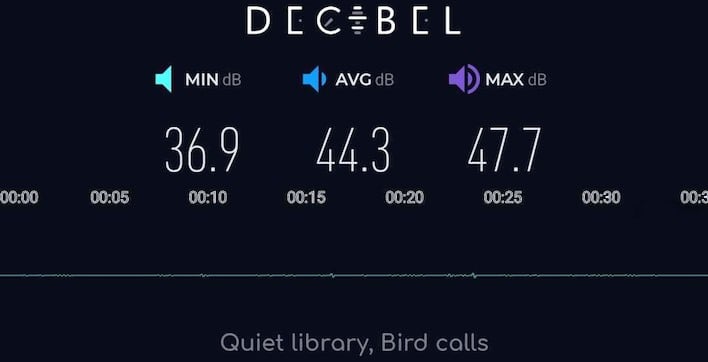
Measuring sound from one foot away during a variety of intensive tasks, the highest maximum sound level we were able to record was just 47.7 decibels. This is far from silent, and you can absolutely hear the fans going. They're not intrusive, though. You can easily talk over them, even at full blast, and the system's speakers have zero issue playing over the fan noise given their impressive maximum volume level.
One complaint we do have about the Zenbook S 14 in this category is that it doesn't insulate the user from the SoC's heat very well. We recorded temperatures above 110°F (43°C) on the keyboard deck, which is pretty toasty. It probably won't be a problem for most users, but if you are gaming and using the laptop's keyboard, you could find yourself with some toasty fingertips.
ASUS Zenbook S 14 (UX5406SA) Battery Life
One of the key goals for Intel with Lunar Lake was reducing system power consumption to improve battery life. We proved pretty conclusively that Intel had closed the gap with its Arm-based competitors in our initial Lunar Lake review, but this Zenbook S machine has a considerably larger battery than that system, and indeed larger than any of our Snapdragon-based laptops. Does that give it extremely long battery life?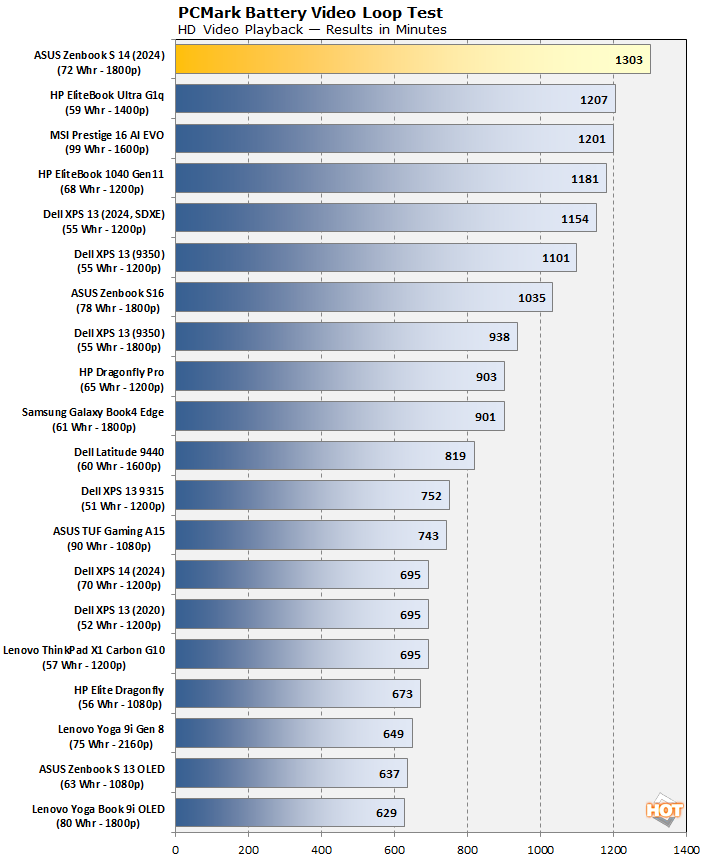
In a word: yes. That is 21 hours and 43 minutes. Admittedly, still well shy of the 27 hours that ASUS claims this machine is capable of, yet this is still a phenomenal result. The battery on this thing outstrips the EliteBook Ultra G1q by nearly a full 100 minutes, with a higher-resolution OLED screen and vastly superior benchmark results in most of our tests.
ASUS Zenbook S 14 (UX5406SA) Review Conclusion And Final Thoughts
There's no shortage of use-cases for a thin & light laptop with this kind of responsiveness. The ASUS Zenbook S 14 with Lunar Lake is not a multi-tasking monster, but if you primarily work in one or two applications at a time—say, Word or Excel and a web browser—this system will serve you extremely well. It'll ride shotgun in even a modestly-sized bag, and it look stylish while doing so. If you forget to charge the ASUS Zenbook S 14 at the end of the day, it'll probably be fine, given the impressive battery life on offer here too.We feel it's important to bring up the hit to performance this machine takes when it's on battery power, though. While we didn't do a full analysis on this system like we did in our original Lunar Lake review, and there are some results from this machine in that testing, so go check it out if you're curious. While the responsiveness of this Zenbook S 14 is outstanding on wall power, it behaves differently on battery. That might be a fair price to pay in exchange for the longest battery life of any laptop we've ever tested, of course, but we can't make that tradeoff decision for you.
We can tell you that you may want a Thunderbolt dock for this system if you intend to use it in a stationary capacity. The three data ports on this machine can fill up quickly, and having to swap peripherals (like an external mouse, storage, or gamepad, while plugged in and charging) is a downer. A dock can resolve this nit-pick, but it is an extra purchase.
Cost is also a consideration, when the ASUS Zenbook S 14 is priced at $1399 out of the gate. We think the majority of the cost comes from the machine's gorgeous OLED screen, which is absolutely worth the price of admission. Still, we have to reiterate that this system doesn't come with particularly fast storage, the multi-core performance trails higher core-count chips, and as fast as the Arc 140V graphics are, there's no replacing a discrete GPU for gaming and some taxing creator workloads. Then again, gaming likely isn't a primary objective for a laptop in this class of laptop. If nothing else, we'd probably recommend ponying up the extra $100 for the Core Ultra 7 258V version with 32GB of RAM.
The ASUS Zenbook S 14 isn't exorbitantly priced, but you do pay a small premium for for its style, thinness and beauty. If you're a design-conscious laptop consumer, looking for a well-mannered, modern machine that just sips power when on battery, you won't find many systems with this level of panache, and we expect it will serve your needs well.







